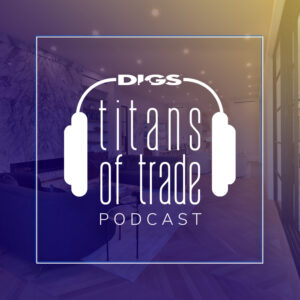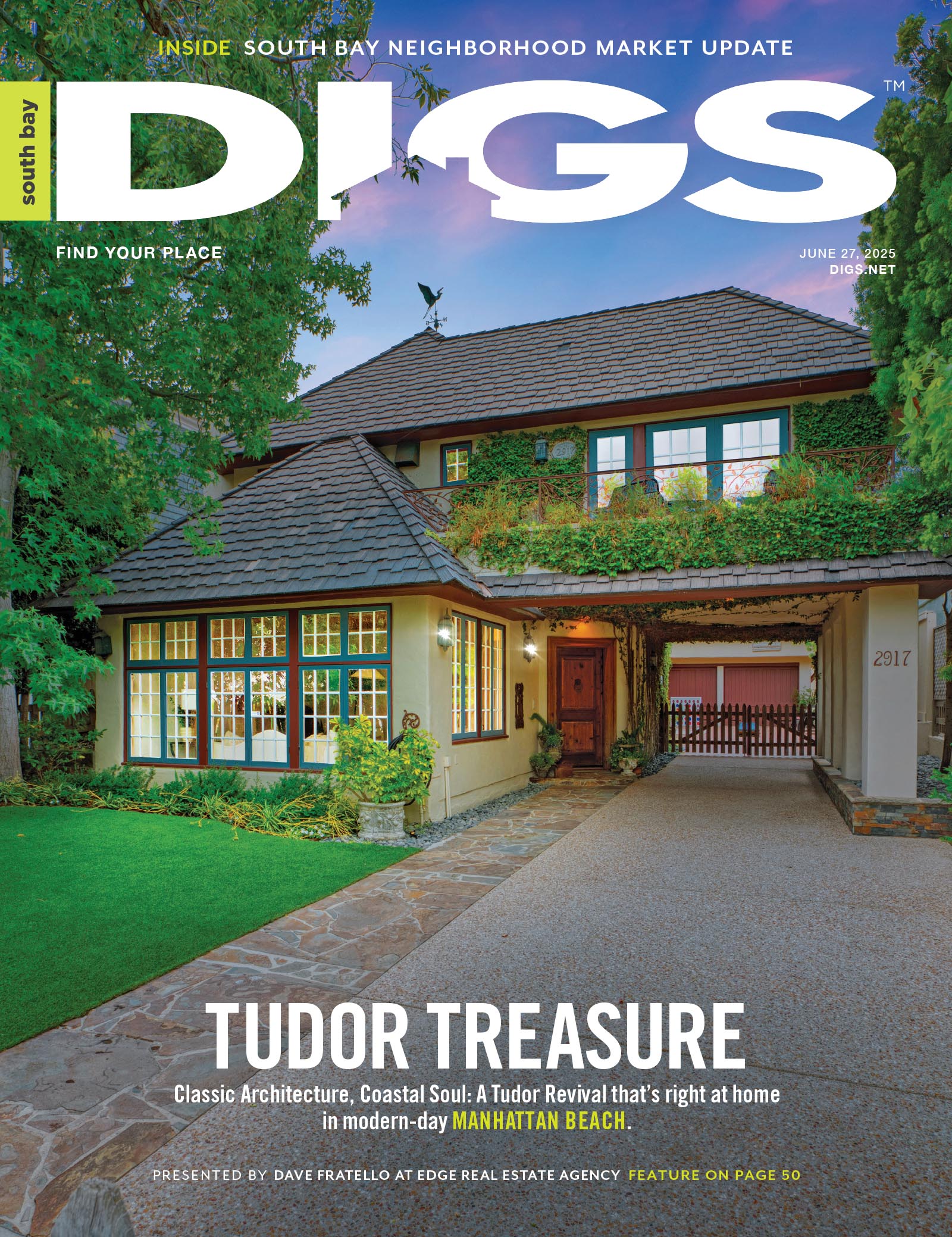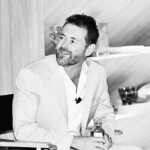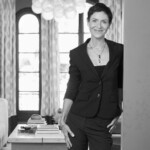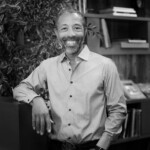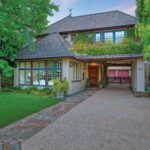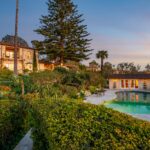Table of Contents
In this Episode
Painter. Textile Designer. Entrepreneur. Serena Dugan’s creative chapters connect from her early days doing site-specific freehand painting, and as a textile artist who did block printing and printed her own fabrics. She then teamed up with boutique owner Lily Kanter and created the uber-successful home brand Serena & Lily before returning to her roots as a painter and an aesthetically free-flowing textile designer whose fabrics and wallpapers are released under her Serena Dugan Studio label.
Serena Dugan joins the podcast to discuss the beauty of non-perfection and the power of checking out, plus shares her personal ideal of business success and plans for a new dream incubator on Shelter Island.
“I tend to not be caught in yesterday’s story because there are too many great things that are possible,” shares Serena Dugan, “and I’d rather not waste my energy thinking about what has happened.”
Episode Resources
Follow Serena Dugan
Follow along with Serena Dugan at serenadugan.com
Full Episode Transcript
00:00:00:06 – 00:00:19:12
Serena
I really want everyone to recognize themselves as creative and find art making and creativity in their own expression as an outlet for them. And the only way they can do that is if they are not judgmental, but they actually can just appreciate the process.
00:00:24:06 – 00:00:35:01
Constance
Welcome to Titans of Trade. I’m your host, Constance Dunn. And today we are joined by Serena Dugan, an artist and entrepreneur. And I’m sure many other things that we are about to discover. Welcome, Serena.
00:00:35:17 – 00:00:37:03
Serena
Thank you. It’s great to be here.
00:00:37:15 – 00:01:00:00
Constance
Yes. So and as I was saying, I’m very excited to talk to you because one of the things that I find so lovely is your Sausalito studio. I think that I imagined the inspiration there and the beauty of what you’ve created on the pier is extraordinary. And I’m curious how that came about.
00:01:00:00 – 00:01:28:09
Serena
How the studio came about. Well, so I, live now half time between Sausalito, California, and Bend, Oregon. But at the time that I found the studio, I was a full time resident in Sausalito. I had lived there for 15 years and I was always curious about this building that was out on the waterfront.
00:01:28:09 – 00:01:54:03
Serena
It had kind of an air of mystery, and I never knew anyone who actually worked there or who knew anything about it. And when I knew that I was looking for more studio space, I my mind immediately went to that building and I got in the car and I drove over there and just started poking around and trying to find more information.
00:01:54:03 – 00:02:17:17
Serena
Eventually, someone walked out of the space that would become my space and I asked him what he knew about the building and if there were any spaces for rent, and he said no, it’s not really available for rental. But I do store paddleboards in there and I’m actually moving them out and I’m going to have space.
00:02:17:17 – 00:02:31:15
Serena
How much space are you looking for? And I told him I would take a corner and it turned out that I got half of his space and then he worked his way out as he sold off his paddleboards and that space has been mine ever since.
00:02:32:10 – 00:02:42:09
Constance
See, I think it’s fascinating that you thought of that space and then you just went and did it. Like, is that what you rely on quite a bit?
00:02:43:02 – 00:03:13:18
Serena
Yeah, I do. I think that that actually is a pretty good metaphor for how I run my life. If I can’t picture it, it doesn’t materialize and that holds true with finding a workspace. It holds true with a new design. It always starts in my head. And if it isn’t clear in my mind’s eye, then it can’t be clear in real life.
00:03:14:15 – 00:03:42:16
Constance
And see your orientation. Just from what I’ve gathered reading about you, you have a very strong forward orientation. And I’m curious because there’s certain people that that are looking to change the orientation that they have of looking back a lot and spending a lot of time back there in previous chapters. And I’m very interested in people like yourself who are always next, next, next, next, next.
00:03:42:21 – 00:03:47:14
Constance
So is that how the way you’ve always been or did you cultivate this consciously?
00:03:48:08 – 00:04:13:16
Serena
It’s a really great observation and question. I haven’t really thought about it in those terms. I think I have always I think I’ve probably always been that way to some degree. I couldn’t tell you why. I couldn’t tell you who my mentor was or what my parents said or what happened to me in my life to make me that way.
00:04:15:03 – 00:04:43:10
Serena
But when you have an idea in your head and you chase that idea and you reach it and then it becomes something else, then you get a maybe some positive affirmation or positive reinforcement that all I have to do is imagine it and really believe in the idea and go for it. And maybe some things will work out and some things won’t, but sometimes they will.
00:04:43:10 – 00:05:13:21
Serena
So why not imagine what you really want? And once you do that, you kind of lose the the backwards focus of that’s more fear based of, you know, what, if I fail or being caught in yesterday’s story, I tend to not be caught in yesterday’s story because there are too many great things that are possible. And I’d rather not waste my energy thinking about what has happened.
00:05:14:12 – 00:05:39:03
Constance
That’s great. And it’s so rational and it really makes sense. Like you cannot make an argument against that. And I love hearing that, that there are just so many wonderful things coming. And speaking of, is there something you work at? You’re a painter and a textile designer and probably other things. Is there something really exciting or next chapter that you wish to share?
00:05:39:22 – 00:06:24:09
Serena
Well, right now the, the bulk of my attention is focused on a project that I have going on in Shelter Island, New York. I bought a house a couple of years ago that I am adding on to and remodeling and building an art barn and attached to this property. And it will be really my incubator. It’s where I get to show and live with my fabrics, my wallpapers, my artwork, and to have kind of an experiential view of what I create is a real treat for me.
00:06:24:09 – 00:06:48:20
Serena
And you know, you could argue that I live between two houses between Oregon and California and those could be my incubators, but they’re not their kind of legacy. You know, I it’s, it’s all my things that I drag around and Shelter Island, this is such a dream property that I am setting it up really as kind of my wonderland.
00:06:48:20 – 00:07:10:20
Serena
And, you know, the outward manifest ocean of my imagination. So that is really where my, my immediate focus is. We should be ready to move in late spring. So I’m in just a full, full design and construction and decorating mode.
00:07:10:20 – 00:07:33:01
Constance
And with that, it’s it’s you seem very open about your spaces, like you let cameras in or you’ll let people in like, I’m going back to the Sausalito one for a minute because it’s a very beautiful space and it seems like you are very, very conscious of how you designed it. Like one areas for this and other areas for this.
00:07:33:10 – 00:07:51:18
Constance
And you seem very open to letting people in there. And so I guess there’s maybe my idea is that there’s a bit of vulnerability sometimes within artists letting someone in seeing a canvas or a work in progress, but perhaps you don’t think of it that way. You wanted to share this. Is that how you thought of it?
00:07:52:15 – 00:08:32:15
Serena
Yeah, I think that that’s a fair statement. I think some people would feel vulnerability around the progress of artwork, but I don’t know that artists really feel that or I can’t speak for all artists, but I find the process of making really fascinating. And if there is one thing I want to lift the veil on, it’s that art looks perfect the whole way through because I feel that if I lift the veil on the ugly parts, you know, the struggle, the half done, the I don’t think I like it.
00:08:32:15 – 00:09:05:08
Serena
Yeah, the it isn’t, you know, it it doesn’t yet look like how I want it to look if would be artists know that professional artist experience that then they will be more likely to push past their own inner critic. I really want everyone to recognize themselves as creative and find art making and creativity in their own expression as an outlet for them.
00:09:05:15 – 00:09:31:15
Serena
And the only way they can do that is if they are not judgmental, but they actually can just appreciate the process. So your question Do I allow people to view something, view work in progress? Do I have vulnerability around that? Absolutely not. I don’t have vulnerability around it because I want people to know that creativity is messy and imperfect.
00:09:31:15 – 00:09:37:06
Serena
And that’s what I want people to see. Not necessarily the bright, shiny final product.
00:09:38:00 – 00:10:10:03
Constance
And that’s powerful coming from you because a lot of your career and a lot of your output has been creating beautiful things and creating beautiful things that people bring into their home to beautify it. And and it’s it’s interesting about that because some of your your ideas behind the things you’ve created and different companies or even I imagine I never saw any of your work as a when you were like a freehand artist, you would be in hotels or restaurants beautifying perhaps.
00:10:10:03 – 00:10:37:03
Constance
That’s not always, you know, making their spaces more about themselves or translating images. So I’m curious about your idea of creating a more beautiful space and the power of it. And I use that word beauty, but it could be whatever someone desires for their space. Beautiful to them, or more practical or more inspiring to the life they want to lead.
00:10:37:03 – 00:10:43:02
Constance
So your ideas of of that and how that impacts the person in their life?
00:10:44:10 – 00:11:22:17
Serena
Well, for me, beauty, a beauty is a perfect word to use, but beauty is not the same thing as perfection. I don’t I do not equate the two. And for many people they think that to beautify means to make perfect. And I don’t. I don’t I’ve never espoused that connection. I’ve never I’ve never stood for that. I, I like to create something that is transportive and beautiful and I believe in creating spaces that have that magic.
00:11:22:17 – 00:11:51:20
Serena
But that doesn’t mean that they are perfect spaces. It does not mean that there’s a right and wrong answer. And I want people to get to the right answer. The right answer is whatever, whatever moves you. So I have my view. You know, that’s my form of creativity. I create something that moves me and people can be moved by that and find it beautiful or not.
00:11:52:20 – 00:12:18:18
Serena
I’m fortunate to have had support in that, in that enough people find it beautiful to keep me, you know, going to work every day and keep me doing it and tell me that I’m on the right track. But I do it to simply feel the satisfaction of creating what I find beautiful, not what I find perfect. There’s no set.
00:12:18:23 – 00:12:20:22
Serena
Perfect would not be beautiful to me.
00:12:21:08 – 00:12:43:21
Constance
Oh, I like that. That’s such an important distinction. And it’s it’s a tough question, but I’m wondering if there is if there’s ever been a top space or a place or a person that’s been so imperfectly beautiful to you or a space that you were walking in some like restaurant and you’re like, Oh, this is this is perfect.
00:12:44:00 – 00:12:47:15
Constance
But it would be conventionally in perfect.
00:12:47:15 – 00:12:55:01
Serena
Absolutely. I can think of a flood of places. None are in the United States.
00:12:55:04 – 00:12:56:17
Constance
Oh, okay.
00:12:56:17 – 00:14:12:11
Serena
That’s probably why I travel, because they’re in. We have the habit. Or maybe the the standard in the U.S. to want to create perfect. And those aren’t necessarily the most inspiring places to me. I find the natural world beautiful. Maybe the reason I like nature is that it is imperfect but beautiful. But the manufactured places, the great restaurants, the beautiful hotels, those are not exactly examples of imperfection in the U.S. However, they are in many places outside the U.S. because they can find charm in crumbled frescoes and imperfectly pigmented plaster walls in Marrakesh and there’s a there’s an appreciation for patina and for age elsewhere that we don’t necessarily capture.
00:14:12:11 – 00:14:16:16
Serena
This country’s too young. I don’t know if that makes any sense.
00:14:16:20 – 00:14:24:06
Constance
It does, because one of my favorite objects is a captain’s chest from my great, great, great grandfather.
00:14:24:23 – 00:14:25:11
Serena
Oh, wow.
00:14:25:19 – 00:14:47:04
Constance
Great Age of Sail was ending around the 1850s, and he was the last in our family to have been a sea captain. And I have his chest and it’s I mean, it’s really old. And so I look at it and it makes me so happy. And sometimes I don’t even want to dust it because I don’t want to remove any of its magic.
00:14:47:20 – 00:15:14:05
Serena
Yeah, I get that. I think that, you know, that age in that where that’s that symbolizes story, you know, that that chest has so many stories to tell. And I think that those stories have a power when placed in a room or you know when there’s when the whole room has an age or antiquity where you just can kind of feel the ghosts of what has come before.
00:15:15:05 – 00:15:53:05
Serena
I don’t know if I’m digressing, but I think there’s true beauty in some in spaces with soul. And I create my pattern is to always have a little quirk and a little hand because I want there to be a reminder that there’s a human behind that pattern and that it’s not a machine. So my hallmark, my fingerprint is always story, imperfection, humanity, soul.
00:15:53:05 – 00:15:55:07
Constance
That’s wonderful.
00:15:56:09 – 00:16:09:04
Constance
You had a B.A. in psychology and then you switched and that during that switch, your studies took you outside of the U.S., is that correct?
00:16:09:10 – 00:16:09:19
Serena
Yes.
00:16:10:07 – 00:16:20:01
Constance
And did you get any flak or maybe it didn’t matter if you did when you went from psychology to then fine art?
00:16:20:01 – 00:16:22:07
Serena
So much flak.
00:16:22:11 – 00:16:46:10
Serena
Yeah, I definitely did. Well, I threw a lot of people for a loop. I was throwing myself for a loop. At the time. I didn’t understand why I was making that switch. My parents, you know, keep in mind, I was young. I was straight out of college. I was applying to graduate programs for clinical psychology when I just froze and said, this is the wrong direction.
00:16:47:02 – 00:17:18:08
Serena
And my parents were standing by. My friends knew, you know, I was firmly moving this direction all of a sudden, took a hard right and it was a lot to explain to people. I didn’t really have an explanation myself, and I tried to kind of ground it in practicality. I was going back to art school, but for graphic design, because that was, you know, at least a career.
00:17:19:03 – 00:17:40:02
Serena
And I found that I didn’t love the computer art programs, which is ironic because so much of what I do is graphic design and I’m on Photoshop a lot. So it was a great foundation, but I pivoted very quickly to the true fine art and painting because that’s what I loved. And then I really couldn’t explain that, but I just told everyone to trust me.
00:17:40:23 – 00:17:58:23
Constance
And that’s great that you did, because I think many people, especially at that age, might have a hard time, you know, standing up for themselves in that regard. And they might think like, I’ll just do it, I’ll just do it, and then do my art on the side and, you know, make everyone happy. So I think that’s that’s great that you did that.
00:17:58:23 – 00:18:12:18
Constance
And then you, of course, very successful. One of your endeavors, Serena & Lily, very successful. And again, another pivot, if you could tell us about that. Yeah, it’s interesting.
00:18:12:18 – 00:18:53:01
Serena
I don’t really see Serena & Lily as a pivot. It was very much, you know, at the at the time. Let’s see, when I started my business as a decorative painter, I let me think about this. So I was at I started when I was living in Colorado, and then I moved to San Francisco and fairly quickly, I started freelancing with Pottery Barn Kids on their photo shoots, and I was an onsite decorative painter working hand in hand with the stylists to create these freehand painted backdrops for the catalog.
00:18:53:21 – 00:19:25:13
Serena
And so I learned about commercial photography. I learned about set work, I learned about the work of photographers and stylists and and that dynamic. And I was specializing in children’s rooms through Pottery Barn Kids. And then when I met Lily, she had a baby, a beautiful baby store, and she wanted to feature some of my work in her store.
00:19:25:13 – 00:19:55:05
Serena
And that was a natural fit. And then she saw my textile designs. I had started a line of block printed fabrics then that I was selling to designers, and she said, Well, I could see this one on a crib bumper or crib bedding. And I said, That’s actually something I’ve been thinking about because I had so much exposure to the nursery bedding and children’s batting from Pottery Barn kids that I just I was kind of a shopper at the time.
00:19:55:05 – 00:20:18:02
Serena
I did not have kids at the time, but I remember thinking, Hmm, this doesn’t speak to me in the direction of the two. At the time I was Choo-Choo trains and bunnies and ducks and something that just didn’t. If it didn’t connect, I didn’t connect to it. And I explain this to Lily, and she said, Well, that’s. There’s a lot on the market.
00:20:18:02 – 00:20:35:07
Serena
I said, Yeah, there’s nothing on the market that I would buy. And she said, Well, what would you want to see? And I described it to her and she said, Well, that’s not what it looks, what her bedding looks like. I said, That’s my point. And she said, Well, do you think your friends feel the same way?
00:20:35:07 – 00:20:57:09
Serena
I said, I’ve never asked them, but I have to believe that I would be a bellwether. And she said, well, let’s partner on something. And so that’s the story of how Serena & Lily was founded. We started with crib bedding, and so that really wasn’t out of left field. It was very, you know, one foot in front of the other.
00:20:57:17 – 00:21:11:12
Serena
Just like everything in life, when you look back, it all makes sense that your lead from one point to the next, as long as you stay open to walking through the door that’s presented.
00:21:12:22 – 00:21:48:03
Constance
And the success of that venture, I came across something you were speaking about and it was so interesting to me. It was the idea of, well, one that was just that is very successful. And then you have a different business. Now, Serena Dugan and you were talking about the fact that a business doesn’t have to follow the conventional trajectory or it doesn’t have to look like what we assume is to be a successful business, like, oh, we’ve had X percent growth and now we have a bigger space and more people and we’re making more money.
00:21:48:03 – 00:21:59:00
Constance
You can have a very successful business as one person. And if you could talk about that, because I found that very inspiring and really wonderful, it was like, Yeah, so it’s finally said it.
00:21:59:18 – 00:22:35:08
Serena
Yes. I remember the interview that you’re you’re mentioning. I said that once and I got so such a wildly positive response to that comment. And it’s shocking to me and wonderful to me that this is a code that we truly have to crack. So, yes, the model of success has traditionally been big, big you know, that that is you are successful if you grow it to X size.
00:22:35:08 – 00:23:16:08
Serena
But I’ve lived through growing it to X size. I’ve lived through growing a big company. And I’m here to tell you that that does not make you more satisfied. It’s not a recipe for longevity, of satisfaction, and it’s not a recipe for profitability. So I’ve lived through every, you know, every scenario. And I set out when I left Serena & Lily to create something that was built around the way I define satisfaction and the way I define satisfaction is small, low to the ground.
00:23:16:08 – 00:23:43:22
Serena
I want to know. I want my team to feel like my family. I want us to all be in it together. I want to see profitability as soon as possible so that you’re not constantly having to feed the beast. Meaning raise money to expand your product assortment and expand the circulation of a catalog. And it’s always more and more and more with these larger scale companies.
00:23:44:16 – 00:24:15:11
Serena
Everything that you see that’s larger scale, it takes a lot to get there. And I just want I wanted to make and I wanted to have fun with my days and that is available right away. So at what point do you then return to the model of okay, it will be successful once I have X number of locations I’m at X sales, I have this number of employees and this is how I’m regarded.
00:24:16:02 – 00:24:49:11
Serena
The answer for me is never. That’s not my recipe. I love to make, I love to paint, I love to create. And so I needed to find the right sales channel to support what I want to make. I wanted a team that could lift off the duties and responsibilities that I don’t enjoy and I’m not good at and stand in the way of me making and I want control of my days and I want to spend every minute of my time in ways that I find satisfying.
00:24:50:06 – 00:24:50:20
Serena
And that’s it.
00:24:52:05 – 00:24:58:09
Constance
And has that always been generally how you thought about business and work.
00:24:58:13 – 00:25:30:17
Serena
No. You know, keep in mind. Oh, and I would add one thing to what I just said. You can run a much stronger business keeping it lean than you can blowing it out, much stronger business much quicker. And that’s a little hack that no one tells you. So sorry. The question Have I always felt that way?
00:25:31:18 – 00:26:01:13
Serena
No. When I started Serena & Lily, I was 30 years old. Keep in mind that my deepest professional experience was Serena & Lily. You know, I was a decorative painter. I was a tradesperson, essentially happy, happy as could be. But I didn’t have executive experience. So my coming of age was Serena & Lily. And kind of follow the model that is set forth without questioning it.
00:26:02:00 – 00:26:26:06
Serena
And for me, the model was I knew that I wanted to design, but I was also running the creative side of the business. So I was both lead designer and chief creative officer, and that gave me the ability to set the vision and execute on the vision and not have to turn over, turn the idea over and wait and see what I got.
00:26:27:10 – 00:27:01:06
Serena
So I did my role was definitely not the way you would see it in other similar organizations, similar retail organizations, because I did. I did both, but I didn’t at that stage know that we were supposed to keep it small. And if I had ever voiced that organic growth felt better than raising money, growing exponentially, raising more money to fund that, growing exponentially.
00:27:01:16 – 00:27:30:05
Serena
Again, if I voiced that I was in the minority, I was in the minority because that’s not the way business is done at that level. It wasn’t an exercise as to keep me the creative happy. It was at that point an exercise to earn our investors money. And once you take on capital, it becomes about setting plan, making plan and earning money for the people who have invested in you.
00:27:30:21 – 00:27:34:21
Serena
And that’s the way big business works. But I had to learn that.
00:27:36:07 – 00:28:07:09
Constance
And I imagine that what you’re doing today. Well, I was I love how you took time and you were able to go paint in France. And and for people out there that given years level of success look at that and are in awe and go how did she do it? How did she but talking to you a little, it seems like you have a very clear idea of things and you execute them.
00:28:07:09 – 00:28:25:08
Constance
And I think that’s very fascinating. And it’s it’s a really wonderful manner. Characteristic. So how did you say, you know, this is it, everybody- bye! I’m going off to do this and I need to immerse myself.
00:28:25:08 – 00:28:54:04
Serena
Well, there’s a dirty little secret that no one tells you, which is when you’re divorced and you share custody, then you have half you know, 50% of your time is available to do what you need or want to do. So I hate to, you know, I hate to put it that way, but I do have time to attend to my own wishes and desires.
00:28:54:04 – 00:29:21:03
Serena
And I have a supportive ex-husband. He knows that this is what I’m about. I asked him a year ahead. I said, this is something I’m thinking about doing. Could we rearrange some time, ideally next spring, or you tell me the best time that I should look for, for me to take a chunk of time to go do some professional development.
00:29:21:19 – 00:29:50:00
Serena
So, you know, essentially, you know, some people could see a a painting residency as play time or arts and crafts. But I see it as good for the soul and professional development. And I am resolved to keep to doing that kind of thing on a regular basis. And my ex-husband knows and supports that. So I’m fortunate in that regard.
00:29:50:00 – 00:29:55:05
Constance
And the location in France of the residency, was it extraordinary?
00:29:57:05 – 00:30:23:02
Serena
I don’t have words. It was it it I don’t know if it was the location or the space or the fact that I carved out time to do it, that I put life on hold. And I didn’t know I, I don’t know what it was or what combination contributed to the feeling of it. Just being feeling like magic to me.
00:30:23:15 – 00:30:46:14
Serena
And one of the most important parts. And I don’t think it had anything to do with France or the beauty of the location. One of the most important things for me was the fact that I didn’t need to know what time it was for two solid weeks. Other than the time of day that I needed to call my kids and I set an alarm for that.
00:30:46:14 – 00:31:16:03
Serena
And the rest of the time I didn’t need to track anything. I was checked out and that kind of experience is really, really powerful for all of us, especially when you’re juggling so many things as a worker or a wife and mother, you know, a husband, any of us, all of us, we should be able to reconnect to Source in whatever way we do it.
00:31:16:03 – 00:31:25:09
Serena
For me, , there are many ways I connect to Source, but painting is one of the primary ways. So it was a magical experience through and through.
00:31:26:12 – 00:31:33:02
Constance
Connecting to Source. That’s a that’s a great way to put it. And so that should be a that is a priority for you.
00:31:33:21 – 00:32:03:04
Serena
Oh, 100%. That’s if there is no way for me to live the life that I’ve chosen to live. If I was disconnected to Source because creative work requires a connection to Source, it’s not execution, it’s channeling inspiration and executing. So you can’t do those things without a sense of feeling grounded and connected.
00:32:03:17 – 00:32:15:23
Constance
So new objects such as like furniture or decor items, your work being integrated on them and released to the public. Is that something that’s, that’s that you’re doing or.
00:32:16:16 – 00:32:45:23
Serena
Yeah, that’s something that I have was my intention to do. As I was getting my studio up and running, I thought that it would be a combination of textiles, artwork and objects because in my past, objects have been very important, you know, clearly with Serena & Lily, with our bazaar that we put together and in any decorative painting, you know, decoratively painted furniture that I’ve done.
00:32:46:13 – 00:33:17:02
Serena
And I wanted to have a collection of objects. And I really worked hard on developing that collection. And I realized there are too many moving parts. And to be in the logistics business is going to really underground me. And it makes me it’s so challenging and it challenges a section of your brand that you don’t really want to challenge if you have to stay creative.
00:33:17:02 – 00:33:34:18
Serena
So it taxed the the operation. Honestly, it was too operational, I should say, operationally challenging. So no objects. I will make peace with that. In my heart I see objects, but practically speaking it was too tricky.
00:33:36:00 – 00:33:50:14
Constance
Are you impacted? Very much because there’s Sausalito, there’s Bend, Oregon, and then there’s Shelter Island, and I can I speculate that there is specific reasoning behind these different locations.
00:33:51:04 – 00:33:59:13
Serena
Yes. Yeah. Yes, definitely. You can speculate, I’ll tell you.
00:33:59:21 – 00:34:00:12
Constance
Yeah.
00:34:00:20 – 00:34:35:01
Serena
Yeah. They’re the reason for the three locations. I mean, let’s move aside Shelter Island for a moment. I’ve lived in Sausalito for 20 years, 22, I guess, or the Bay Area for 22, Sausalito for just under 20. And it is my community. It’s my home. I love Sausalito for many reasons and it is really my creative center.
00:34:35:01 – 00:35:11:02
Serena
I made the move to Bend for my kids. It was time to move them out of the Bay Area. I realized that during COVID there were better. We needed more wide open spaces and my ex husband really wanted to move. So it was really in support of the family, him and my kids. But I said in order for me to move, I need to keep my headquarters in Sausalito, keep my life set up and make it commutable and Bend happens to be commutable easily commutable its an hour flight, easy flight.
00:35:12:04 – 00:35:37:19
Serena
So I can easily go back and forth. So Bend is nature, you know, I’m here for the nature, for the peace, for the ease. It’s a great place to raise kids. I love to ski, I love to be outdoors, I love to hike. So that is what Bend offers. And then Sausalito offers community and beauty and creativity. And really, you know, my roots are there.
00:35:38:04 – 00:36:07:21
Serena
Yeah. So I find strength in while it’s hard to toggle between the two, it is very energizing to do it as well because you’re constantly getting nutrients over here and bringing that and infusing this life with those nutrients and vice versa. Now, Shelter Island, just to you, I add one more thing that I’m juggling. Shelter Island has its own nutrients for me.
00:36:08:06 – 00:36:42:23
Serena
I grew up on the East Coast. I insist on being out east for some portion of the summer because it’s grounding. It feels like home in the most significant way for me. Summertime, you know what you miss in California or at least northern California, is warm. It’s not it does not feel like summer and going through the seasons that is in you know, if you grew up with four seasons, it’s very hard to not live with four seasons.
00:36:42:23 – 00:37:10:16
Serena
So Shelter Island is really an outpost where I can get summer and it is I’m in New York regularly. So there’s, you know, there’s a it makes sense to have a flag planted there how I use it and when I use it that is later on’s problem I’m not sure but it’s it’s the right thing.
00:37:11:07 – 00:37:13:08
Constance
It’s later on’s problem. That’s my new bumper sticker.
00:37:13:08 – 00:37:17:13
Serena
Later on’s problem.
00:37:17:13 – 00:37:29:13
Constance
So is there anything you wanted to share about how you can connect to Source personally on a daily basis when you’re not in some beautiful locale?
00:37:29:13 – 00:37:54:07
Serena
Well, I don’t really need to be in a beautiful locale to reconnect to Source. I learned early on when my kids were very young that I needed some peace and quiet in the mornings. That’s when I really need to ground. And I learned that the hard way because they used to wake me up, you know, from a deep slumber.
00:37:54:07 – 00:38:19:18
Serena
They would wake me up and keep talking about whatever they went to bed talking about. And I realized I need to start my days quiet. So I would wake up at 4:30 in the morning to beat their wake up time and just sit in peace. So do I meditate? Yes. Irregularly. Poorly? Well sometimes. Poorly most of the time.
00:38:20:05 – 00:38:48:23
Serena
But really, meditation for me is just about quiet time where I can hear myself think and kind of recenter. And when I recenter, I do think about the day before what happened, what I can take away, that I can appreciate and absorb that. And I think about my day ahead and set some intentions about what I’d like the day to feel like and what I want to get done and how to like, how to frame that up.
00:38:49:06 – 00:39:11:06
Serena
And I insist on getting that time, that quiet time every morning. So it really has nothing to do with the beauty of my environment. It has to do with my ability to find center and just, you know, a center is in here. It’s not out here. And we all have our different ways of doing that. For some, it’s going for a run for me, it’s sitting quietly in the morning.
00:39:12:09 – 00:39:35:06
Constance
And I’m sure you’ve had those experiences. You learned, like you said, the hard way when you didn’t have that, and it was just off to the races at all day. We have some pictures of work just and I always love to share some of those for those who are maybe watching this on YouTube to take a look, if you could just grab bag one.
00:39:35:13 – 00:39:44:15
Constance
And it’s always nice to get a sense from the artist what might have been going on at the time or perhaps some of your ideas behind this work.
00:39:44:20 – 00:39:48:20
Serena
Okay.
00:39:48:20 – 00:40:19:08
Serena
So this is a this is a studio. Shot of my new block print collection. And this is what you see is actually a mix of block printed fabrics and some wallpapers that were based on those block printed patterns. So if you were to be, you know, get a close up view of this, you would see the detail and the beauty of and the artisanal nature of Indian block prints, but that was really a labor of love and those are my roots.
00:40:19:08 – 00:40:47:00
Serena
I started as a, as a block printer where I would print my own fabrics. And then Serena & Lily I had the great gift of being able to go over to India and work with these master craftsman. And so to be able to then infuse that back into my my own collection was really meaningful. So this is also the condesa pattern interpreted as a rug.
00:40:47:00 – 00:41:24:07
Serena
And this is a collaboration that I’m really, really excited about. With Eric Lindström Rugs out of Los Angeles, he works with unbelievable crafts people in Nepal, and he interpreted three of my designs in four unique colorways for each as 12 different threads. This pattern was the last pattern that I added to my original collection, and I didn’t add it until I stood back from the collection as a whole, you know, is spread all over my walls.
00:41:25:04 – 00:41:56:15
Serena
And I thought, okay, this feels nice, safe but it doesn’t yet have me as an artist present. It has me as a designer. The difference being art is a little bit riskier. It’s a little bit more of a statement, whereas pattern is repeated and predictable. And I wanted something that would allow me to really present my point of view in color and shape and form and geometry.
00:41:57:00 – 00:41:59:16
Serena
And so that’s how this was designed.
00:41:59:16 – 00:42:07:16
Constance
Excellent. And the is there one more photo?
00:42:07:16 – 00:42:40:09
Serena
And so this is a second rug from the collection. And I believe that we chose these photos because they’re the most recent addition that I’ve made with the common denominator being that all about craft and artisan work. And really that is my those are my roots. So the BLOCK printed collection that is about the craft, the master craft of of block printing, which is such a part of who I am as a as a creative and a designer and artist.
00:42:40:22 – 00:43:14:20
Serena
And this is about the the, the beauty and skill and craftsmanship of a woven rug. And to see your designs executed with such exquisite skill is really a treat. So this is the second pattern. It was also based on a piece of art that I did. Eric really wanted to focus on my artwork rather than my pattern work and interpret my art underfoot.
00:43:14:20 – 00:43:17:03
Serena
So this is a beautiful example.
00:43:17:15 – 00:43:21:14
Constance
How exciting for you to see this for the first time.
00:43:21:14 – 00:43:23:08
Serena
Oh my gosh, I don’t have words.
00:43:23:11 – 00:43:29:11
Constance
Yeah, yeah. Because it’s, it’s, it’s based on your painting. How, how interesting that connection, right?
00:43:30:00 – 00:43:53:17
Serena
Yeah. Well, when I first saw the rugs, it was for our launch party in L.A., and he had 11 by 14 rugs in all colorways hung at his giant, beautiful space. And I walked in and I saw this giant version of my artwork so beautifully executed. And it was just really meaningful.
00:43:53:17 – 00:44:15:01
Constance
Definitely. And when you are selecting a medium, so perhaps there’s this kernel of this idea and then it’s either textile, design, or painting, or perhaps something else, you know, intrinsically, you know, which one to toggle, which one you are going to select.
00:44:15:18 – 00:44:36:23
Serena
Well, I know once I see the idea, once I can imagine the idea that either wants to be in, you know, a repeat or a, you know, in a rectangle of its own, I know what it’s supposed to be based on. I it’s hard to explain, but I know.
00:44:37:08 – 00:45:11:02
Constance
I imagine and thank you so much. We really appreciate it. I mean, we’ve talked about business and so many things, and I love your perspective. I think it’s very distinct and I like how decisive it is and strong. And I think it’s really wonderful for other people to hear it, especially your approach and how firm you are and how sure you you are or it’s, you know, it seems very you were very sure of things in your vision.
00:45:11:09 – 00:45:28:14
Constance
And you are faithful to them. You go with them. It’s not a I’ve been thinking about it, but whatever, it’s not going to work because you know, A, B, C, and D, you’re just like, what did you do? And it seems like you’ve done that for a long time. And I just I really applaud that. And I think it’s I think it’s a really great thing for other people to hear.
00:45:29:11 – 00:45:33:20
Serena
I really appreciate that. I guess I’ll take it.
00:45:34:08 – 00:45:39:08
Constance
Absolutely. Sold. All right Serena, have a lovely day. Thank you so much for joining us.
00:45:39:08 – 00:45:47:19
Serena
Thank you, Constance. I enjoyed it.
